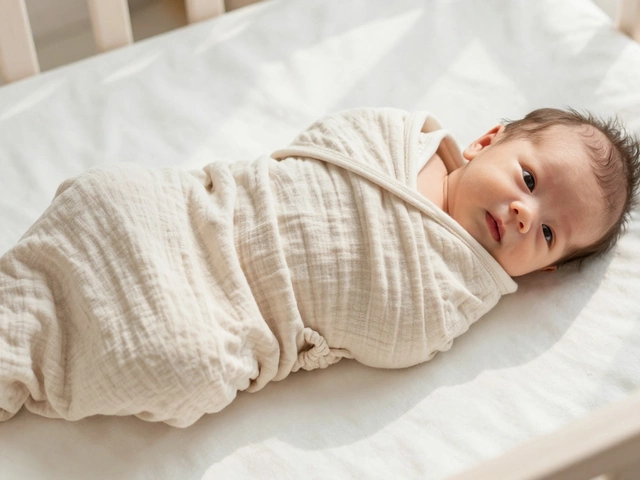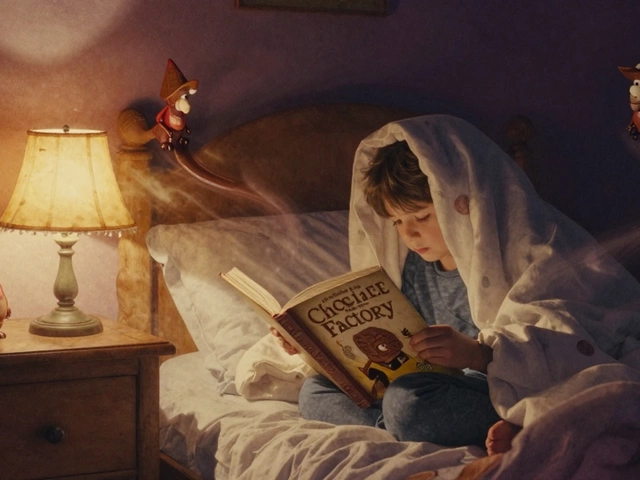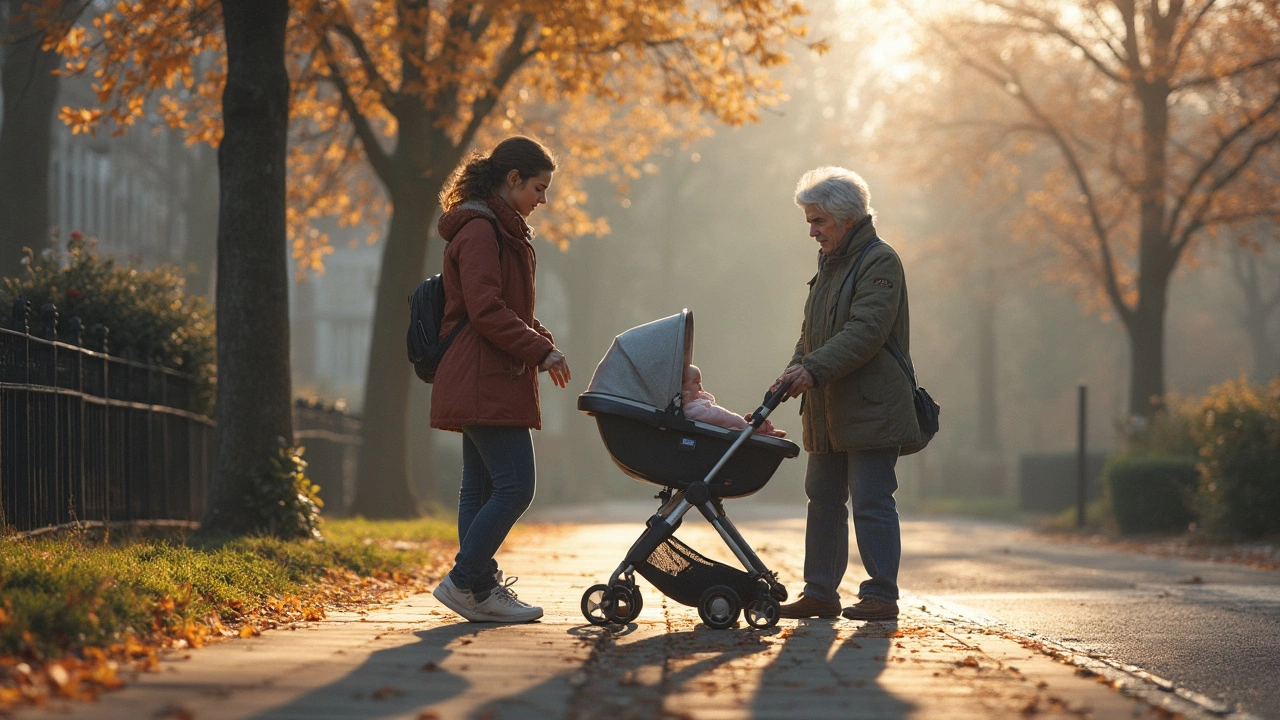
Newborns are tiny, but their need for closeness is huge. Most doctors say for the first few weeks—think four to six—it’s best if babies stay close to mom or their main caregiver. That’s when they’re still getting used to life outside the womb. They want warmth, feeding on demand, and that heartbeat they’ve known for months. Leaving a newborn alone for long, even in another room, just isn’t recommended during this stage.
But real life happens. Sometimes you need to strap your newborn into a stroller to grab groceries, sit in the sun for a few minutes, or just let someone else help. The big thing here: super short separations, like a bathroom break or a quick handover to another trusted adult, are fine as long as your baby is in a safe spot and supervised. Any longer than that? It’s usually safe to wait until your baby’s a little older and feeding routines are more settled.
- Why Staying Close Matters
- Recommended Separation Windows
- Stroller Basics for Newborn Outings
- Signs Your Baby Is Ready for Short Separation
- Tips for Smooth, Stress-Free First Walks
Why Staying Close Matters
Newborns aren’t just being clingy—they’re wired to need their moms close by. Right after birth, a baby’s brain is still developing, especially the parts that deal with stress and safety. Being near their mother helps stabilize things like heart rate, body temperature, blood sugar, and even breathing. The first weeks, called the fourth trimester, are all about staying safe and comfortable while babies adjust to the outside world.
Using skin-to-skin contact—not only right after birth but as much as possible in those first weeks—has proven benefits. For instance, babies who get more skin-to-skin time tend to cry less and sleep more soundly. Moms also benefit with lower stress and a stronger milk supply.
| Benefit of Staying Close | How It Helps |
|---|---|
| Regulates baby’s body temperature | Prevents overheating or chilling |
| Stabilizes heart rate and breathing | Lowers risk of breathing issues |
| Boosts feeding success | Easier breastfeeding, less fussiness |
| Reduces crying | Babies feel calmer, fall asleep faster |
| Strengthens immune system | Contact with mom passes on antibodies |
Experts from the World Health Organization suggest that for the first six months, babies should sleep in the same room as their parents, not in a separate nursery. This isn’t about being overprotective. Babies are still building their ability to regulate their own systems. It’s way easier for them to wake up, eat, and go back to sleep if mom or dad is nearby, especially during those tricky midnight feedings.
Sure, life means you’ll need breaks—or to wheel your baby out for some fresh air in a stroller. But as a rule, frequent closeness is just what tiny humans need to thrive. That’s why many parenting books and pediatricians say the first six weeks aren't the time for long separations, especially if you want a smooth start with feeding, sleep, and keeping your newborn content.
Recommended Separation Windows
Wondering how long a newborn can really be away from mom or their main caregiver? It depends a lot on the baby’s age, health, and feeding routine. In the first two weeks, it’s best to stick close. Experts like the American Academy of Pediatrics say newborns under one month should only be apart from their main caregiver for very short times—think 10-30 minutes. This helps keep feeding on track and gives your baby the comfort they need while they adjust to the new world.
After about a month, you can stretch separations a bit longer—maybe up to an hour—if your newborn is feeding and sleeping well and is in the care of someone who knows their cues. Breastfeeding, formula, or a mix? That matters too. Babies who are breastfed usually need to be with mom more, since feeding can be unpredictable in those early weeks. Bottle-fed babies might handle slightly longer breaks, as long as someone can safely feed them if they get hungry.
Here’s a quick look at guidelines based on baby’s age:
| Baby's Age | Max Recommended Separation | Notes |
|---|---|---|
| 0-2 weeks | 10-30 minutes | Only if needed, for essentials (bathroom, quick shower, etc.) |
| 2-4 weeks | 30-60 minutes | As long as feeding is sorted and baby is with a trusted caregiver |
| 1-3 months | 1-2 hours | If baby is healthy, gaining weight, and happy with bottle or breast |
Make sure whoever you leave your baby with knows the basics: how to feed, burp, and calm your little one. If you’re using a newborn stroller to step out for a breather, keep it short and check in often. Trust your gut, watch your baby’s reactions, and remember—these short stretches apart help you both build a little confidence.
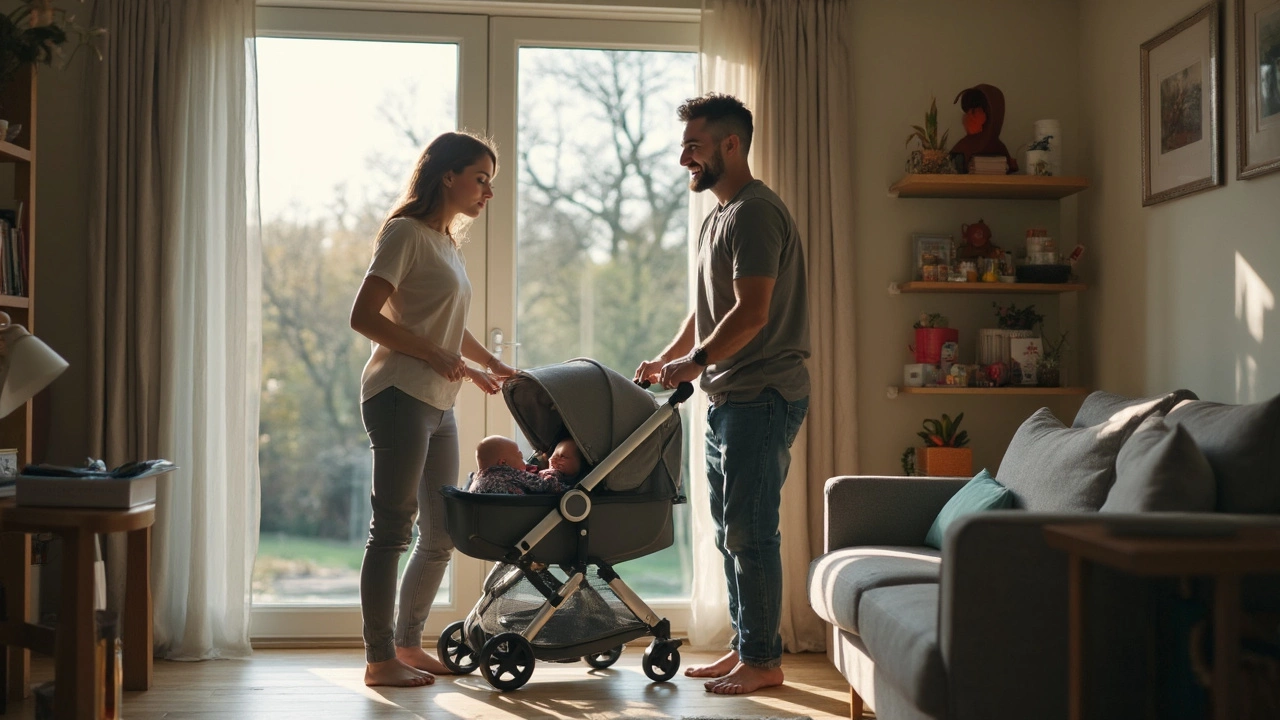
Stroller Basics for Newborn Outings
If you’re heading out with your baby, picking the right stroller can actually make or break an outing. Not every stroller is made for newborn safety. For these tiny passengers, you need a stroller with a fully flat recline or one that connects to an infant car seat or bassinet. That’s because newborns don’t have neck strength yet — letting them slump in a seat that sits up just isn’t safe.
The label should clearly say “suitable for newborns” or “from birth.” Some newer models have special inserts just for extra-small babies. One thing to double-check: the harness. A 5-point harness is best, making sure your baby doesn’t wiggle their way out. And don’t forget about the sun—many strollers have canopies with UPF protection built right in, which is a lifesaver even if you’re just walking to the mailbox.
When it comes to features worth having, make sure your stroller has:
- Full recline or bassinet attachment for flat lying
- Easy steering and smooth suspension—it helps with curb hopping and keeps things less bumpy
- Ventilated sides and breathable fabrics for airflow
- Good brakes, because parking on a slope with a squirmy baby can get sketchy fast
- Storage basket (you’ll thank yourself during diaper blowouts on the go)
Worried about whether your stroller stacks up? Here’s a quick cheat sheet with stats:
| Stroller Feature | Why It Matters | What to Look For |
|---|---|---|
| Flat Recline/Bassinet | Supports developing spine | Seat lays fully flat or has bassinet clip-in |
| Harness | Keeps baby secure | 5-point harness, adjustable straps |
| Sun Canopy (UPF) | Protects baby’s delicate skin | UPF 50+ rating if possible |
| Ventilation | Prevents overheating | Mesh panels, breathable seat fabrics |
| Front Wheel Suspension | Minimizes bumps for comfort | Lockable front wheels, good spring action |
If you’re in the store, don’t be shy about testing the recline and giving the canopy a good tug. Ask the staff if you’re not sure about the newborn setup — they get these questions all day and can usually show you right there. For babies under six months, unless your stroller has a bassinet, you really do need the seat to recline flat; slouching isn’t just uncomfortable — it can mess with breathing.
Final tip: regular stroller cleaning. Spit-up, crumbs, and mysterious stains appear non-stop. Removable, washable covers can save your sanity and your stroller. Take five minutes every week to shake out crumbs and wipe down handles and fabrics. A clean ride is a comfy ride — for you and your baby.
Signs Your Baby Is Ready for Short Separation
Every newborn is different, but there are some clear clues your baby gives when they might be able to handle a short break from mom—like a walk in the stroller with another caregiver or even a little time in a bassinet while you shower. It’s not about hitting a magic age; it’s about your baby’s signals and routines.
Here’s what to look for:
- Feeding is predictable: Once your newborn gets the hang of feeding, whether it’s breastfeeding or formula, and goes two to three hours without getting frantic, those short separations are easier on everyone.
- Naps are settling in: If your baby snoozes peacefully for at least an hour or two and wakes up calm, you can plan quick solo steps away during sleep.
- Comfort with other caregivers: Does your baby settle (even a little) with another adult? That’s a green flag for letting Grandma or Dad take over, maybe on a stroller stroll.
- Your recovery matters: If you’re feeling stronger physically and less stressed, it’ll be easier for both of you.
According to the American Academy of Pediatrics, "Babies who are gaining weight, feeding well, and have established routines are usually ready for brief separations around 4 to 6 weeks." There’s no race—go at your baby’s pace.
“A newborn’s need for closeness fades gradually once feeding is going well and parents feel confident. Short walks or breaks become easier by the end of the first month,” says Dr. Liza Thompson, pediatrician at Boston Children’s Hospital.
Baby monitors and strollers with flat, sturdy bases offer peace of mind for those first separations. And remember, even 20-30 minutes apart is a win when you’re new to parenting.
| Sign | What It Looks Like |
|---|---|
| Stable feeding | Feeds every 2-3 hours, less fussing between |
| Nap patterns | Sleeps for 1-2 hours, wakes calmly |
| Calm with others | Settles with another caregiver |
| Parental well-being | Parent feels ready for a short break |
Don’t ignore your gut. If your newborn fusses every time you step away, it’s normal! But keep trying short breaks—start with minutes, then work up as both of you get used to the idea.
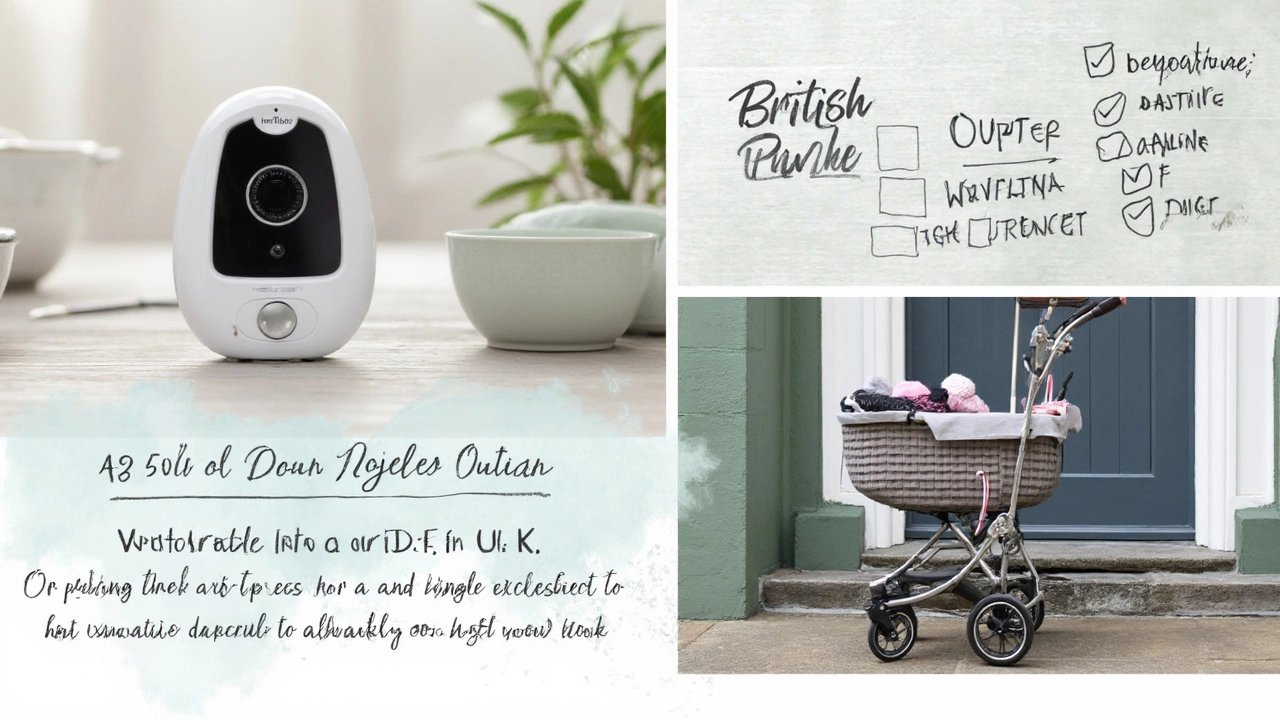
Tips for Smooth, Stress-Free First Walks
Taking your newborn out for the first walk in a stroller can feel pretty nerve-wracking. But it doesn’t have to be stressful if you follow some simple tips. The first step is checking the weather—newborns can’t handle heat or cold well. Aim for temperatures between 68°F and 72°F (20°C to 22°C) and skip midday sun. Light layers and a breathable blanket work way better than piling on heavy clothes.
Your stroller matters, too. Make sure it’s labeled as safe for newborns and has a flat recline. Most experts agree that babies under 3 months should lay almost flat in the stroller since their neck muscles aren’t developed. Secure the harness snugly, with just enough room to slip in two fingers. Always keep the stroller brakes on when you stop, and never hang heavy bags from the handle—strollers can tip over easily.
Newborns still need to feed a lot—sometimes every 1 to 3 hours—so plan for quick breaks. Pack one small bag with basics: a couple of diapers, wipes, a change of clothes, and a lightweight blanket. If you’re breastfeeding, a water bottle and snack for yourself help. Bottle-feeding? Pack milk in a cooler pouch.
- Stick to short walks at first—20 or 30 minutes tops—just around your neighborhood.
- Keep your phone close in case you need help or directions.
- Watch your baby’s face for signs of being too hot, too cold, or uncomfortable; fussiness, flushed cheeks, or shivering are signs to head home.
- Pick routes with smooth sidewalks and shade when possible.
- If your baby naps, make sure their head doesn’t flop forward by keeping the seat flat and using rolled blankets if needed for support.
Most of all, trust your gut. If something feels off, it’s ok to cut the walk short and try again tomorrow. With a little practice and planning, first outings quickly get easier. Pretty soon, heading out with your newborn will feel like second nature.


